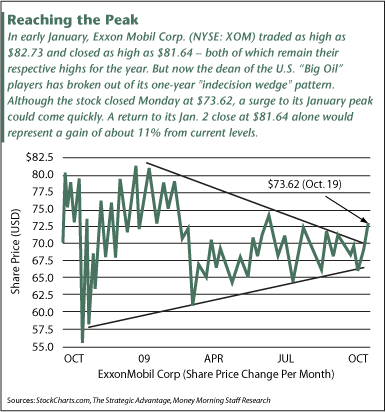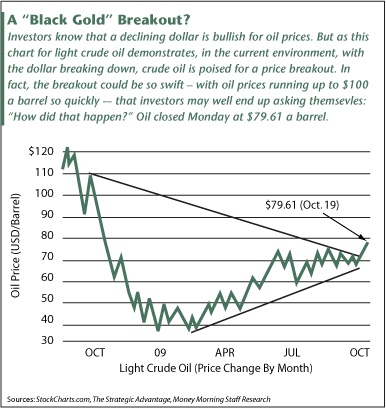The shares of energy-sector heavyweight ExxonMobil Corp. (NYSE: XOM) could return to their highs for the year - a run of 10% or better - thanks to a bull-market event that I like to describe as the "beta chase."
Large-cap stocks rose quite a bit more than their small-cap brethren last week, leading me to believe that we're witnessing a shift in the balance of power between them. It would certainly fit our theory of what's likely to happen over the rest of this year, because fund managers who need to buy stocks in a hurry cannot mess around with small caps: They are too hard to purchase without moving their price.
I believed that money managers who found that their performance was trailing the market would opt to buy large-cap technology stocks: They're among the easiest to purchase and to justify from a growth perspective.
But tech stocks are already up quite a bit. And they currently feature relatively full valuations.
So it's very possible that the "beta chase" for the fourth quarter will involve the much-more-undervalued large-cap companies. Just a few short weeks ago, I noted that the companies in this group were flatlining toward the apex of "wedge" indecision patterns, but could start to rally hard if they emerged above their wedges.
And it looks like that's just what's happening now. And that's actually quite fascinating. You see, you can't have a beta "chase" in stocks in which there is no beta. That's pretty obvious. But if you can get those big stocks running - providing returns greater than the market, which is the colloquial meaning of beta - then the managers can have their cake and eat it, too.
They can buy companies that are large enough to purchase in size, and which are relatively cheap, and which have potential to rise briskly.
One such company is Exxon.
Anticipating New Highs
I identified Exxon as a candidate for a breakout a couple of weeks ago, when it was still mired within the wedge of indecision.
It's no longer mired.
As the chart below shows, Exxon's stock broke out late last week, and is now on the loose. Just to get back to its January level - when it was trading at about $80 a share -Exxon's shares would need to advance 9.6%.
And they could move higher.
In early January, Exxon's shares traded as high as $82.73 and closed as high as $81.64 - price points that remain their respective highs for the year. A return to its Jan. 2 close at $81.64 alone would represent a gain of about 11% from current levels, a major move for a stock like this. And to technicians, the wedge breakout measures to $88.

Mind you, the share prices of many large industrial companies are beyond their January 2009 levels. Major oil producer Apache Corp. (NYSE: APA) is back to its July 2008 level. And shares of energy-and-chemical conglomerate Occidental Petroleum Corp. (NYSE: OXY) are trading at levels last seen in September 2008.
You get the picture.
Now here's a weird coincidence. You know that ExxonMobil has the largest capitalization in the market, which means it has the largest influence on the value of the Standard & Poor's 500 Index. And you know that I have been forecasting that the S&P 500 is likely headed to the 1,200 level.
That number was picked for two reasons:
- It is the level promised by the inverse head-and-shoulders pattern traced out earlier this year, and because it was the level from which the bottom dropped out last year after the Lehman Brothers Holdings Inc. (OTC: LEHMQ) bankruptcy.
- Our expectation has been that all the monetary and fiscal stimulus will - at minimum - buy the government a "mulligan" on that decision, which for you non-golfers means a "do-over."
So let's say that ExxonMobil does surge back to its January level. And let's say it drags along such big-cap energy cohorts as ConocoPhillips (NYSE: COP), Chevron Corp. (NYSE: CVX), Occidental Petroleum Corp. (NYSE: OXY) and Schlumberger Ltd. (NYSE: SLB). Well with their joint heft, these companies have the wherewithal to impel the market benchmark indexes toward the goal line we've set.
In fact, it just so happens - and here's the coincidence - that if you added 9.6% to the S&P 500's adjusted Monday close of 1,097.91, you end up with precisely 1,200. Just as I predicted.
Big Oil = Big Returns?
Now I could give you a lot of fundamental reasons that ExxonMobil deserves to move higher, including:
- A declining dollar is good for oil prices, and may actually help "black gold" break out (refer to the following chart).
- Higher emerging market demand is good for oil prices.
- ExxonMobil has a lot of natural gas interests, and the coming winter is expected to be colder than usual, which normally puts a lot of strain on natural gas prices.
- Moreover, a wet autumn in the Midwest has caused the grain crop to be waterlogged, and I'm told the crops must be dried out via a process that burns up a lot of natural gas.
- And, finally, an improving economy will demand more gasoline than expected, which also helps the integrated energy giants, which get a lot of their income from wholesale gasoline.

That's quite a list of positives. Let's now talk about valuations.
Exxon's trailing Price/Earnings (P/E) ratio is a modest 11.7, quite a bit lower than the P/E range of 13 to 15 the shares were accorded from 2005-2008, or the earnings multiple of 15-18 the shares carried in 2003-2004.
And Exxon's earnings are in the process of turning around.
In fact, investors can figure that growth over the next year will clock in at 10% on a normalized basis. That would make the multiple - and the stock - very alluring to value-oriented money managers, and the turnaround potential attractive to growth-at-a-reasonable price (GARP) managers.
And if Exxon's shares can maintain their recent price action, they will catch the attention of "momentum" managers, too.
Those are three pretty big "ifs." But if all three play out, Exxon shareholders will hit an investor's trifecta. And let's be honest: Were this idea a slam-dunk, there wouldn't be this kind of reward potential.
To take advantage of this idea, you can just own ExxonMobil, or one of these exchange-traded funds (ETFs):
- The SPDR S&P Oil & Gas Equipment & Services (NYSE: XES).
- The SPDR S&P Oil and Gas Exploration and Production (NYSE: XOP).
- Or the Claymore/SWM Canadian Energy Income Fund (NYSE: ENY).
I know they're up a lot recently, but if we have indeed embarked on a "beta chase," there will not bean any easy entries.
That's why they call it a "chase."
[Editor's Note: New Money Morning contributor Jon Markman is a veteran portfolio manager, commentator and author. He is currently the editor of two investment-research services, Strategic Advantage and Trader's Advantage. For information on obtaining a two-week free trial to the daily commentary of the Strategic Advantage, please click here. Anthony Mirhaydari was the research assistant on this column.]
News and Related Story Links:
- Money Morning Week Ahead:
High-Quality Stocks Ready to Take the Lead in the U.S. Market. - Wikipedia:
Head-and-Shoulders Pattern (Technical Analysis). - About.com Golf:
Mulligan. - Investopedia:
Price/Earnings Ratio. - Wikipedia:
Beta. - Investopedia:
Value Investing. - Morningstar.com:
Growth at a Reasonable Price (GARP). - Wikipedia:
Momentum Investing.


